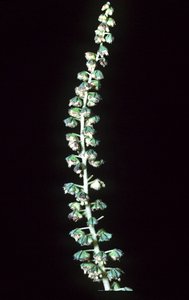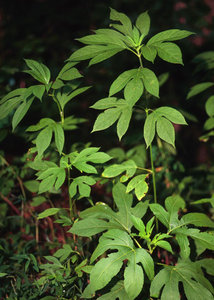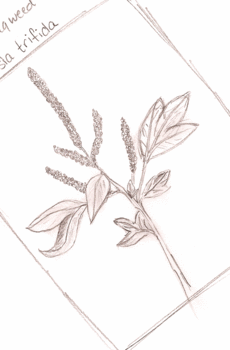Lakota name: canhlōģaŋ paŋśpaŋjela which means “bulky weed” and another Lakota phrase used to describe this plant is yamnūumnuģa iyécéca which means “it is like making a noise by crunching your teeth”. They say this because this plant’s seeds are very hard.
 Listen to Lakota Plant Name: caŋĥlóĝaŋ paŋśpaŋjela
Listen to Lakota Plant Name: caŋĥlóĝaŋ paŋśpaŋjela
As you can see I am researching the great ragweed, or Ambrosia trifida. Here is some information that I hope will help others. When the ragweed blooms its flowers are usually a greenish color. This plant normally blooms around August and September.
It's seeds are usually scattered by wind, animals, water, and by man. When an animal (or man) walks past this plant, the pod, or top of the plant, is bent to one side and then when it is released it springs forward, throwing the seed a short distance. Others are stuck to the muddy feet of animals. Rains wash them from place to place or wind and dust blow the seeds great distances. It is observed that weedy plants usually possess excellent methods for scattering their seeds.
Ambrosia trifida’s common name is known as the giant ragweed, great ragweed, or horse-cane. It comes from the Asteraceae family. Plants in this family have flower heads composed of many florets. Sunflowers and goldenrods are some of the known similar species.
The giant ragweed is in all fifty states except Nevada, Alaska, and Hawaii. The giant ragweed is a medical plant used to treat bites, stings, fevers, infections, and so forth along with the seeds being medicinal. The effect of pollen from this plant upon the sinuses of humans’ result in the condition known as hayfever, which is an allergic inflammation affecting the mucous membranes of the eyes and respiratory tract. It normally occurs during summer. The giant ragweed is known as one of the worst weeds, including some others such as cocklebur, sandbur, and the sunflower. The ragweed plant is native to North America and is considered invasive both in its native area and other parts of the world, including several countries in Europe. The giant ragweed is considered a public concern due to the allergenic properties of its pollen. The ragweed is a minor invasive threat to uplands. In the Black Hills, along with other regions, this plant is known to be very troublesome.



Ambrosia trifida. Left: inflorescence © Robert H. Mohlenbrock. Right: foliage © Ted Bodner.
The seeds have high nutritional value, consisting of 47% crude protein and 38% crude fat. They may be an important food source for rodent and invertebrate populations in agricultural and early succession ecosystems. The seeds of the giant ragweed are more of an incidental food source rather than a preferred food source for some animals, such as beetles and rodents. The giant ragweed is a native annual plant from 3-12 feet tall, branching occasionally. The larger leaves are divided into 3 or 5 lobes usually along the margins, and have long petioles that are sometimes winged. Some of the giant ragweed’s characteristics are that it is annual and it is a sub shrub. Annual, in other words, means that it grows from a seed to maturity and then dying in one season, or every year. A sub shrub is shorter than a shrub and often has weak wood, yet continuously existing only for a few years, if that. Normally, this plant’s habitat is within moist prairies, (especially along woodlands or fields) sedge meadows, Southern lowland, and upland forests.
It is said that the giant ragweed has a low sensitizing capacity for Dermatitis, which is an inflammation of the skin. Some of the secondary compounds of Ambrosia trifida are poisonous, for example, cardiac glycosides, alkaloids, lactones, and essential oils. In an experiment isolating Ambrosia trifida's essential oils through steam distillation, thirty-five compounds were identified. Ambrosia trifida essential oil demonstrated bactericidal and fungicidal activity against six bacterial strains and two fungal strains, using agar diffusion methods.




 Go to quick links
Go to quick search
Go to navigation for this section of the ToL site
Go to detailed links for the ToL site
Go to quick links
Go to quick search
Go to navigation for this section of the ToL site
Go to detailed links for the ToL site